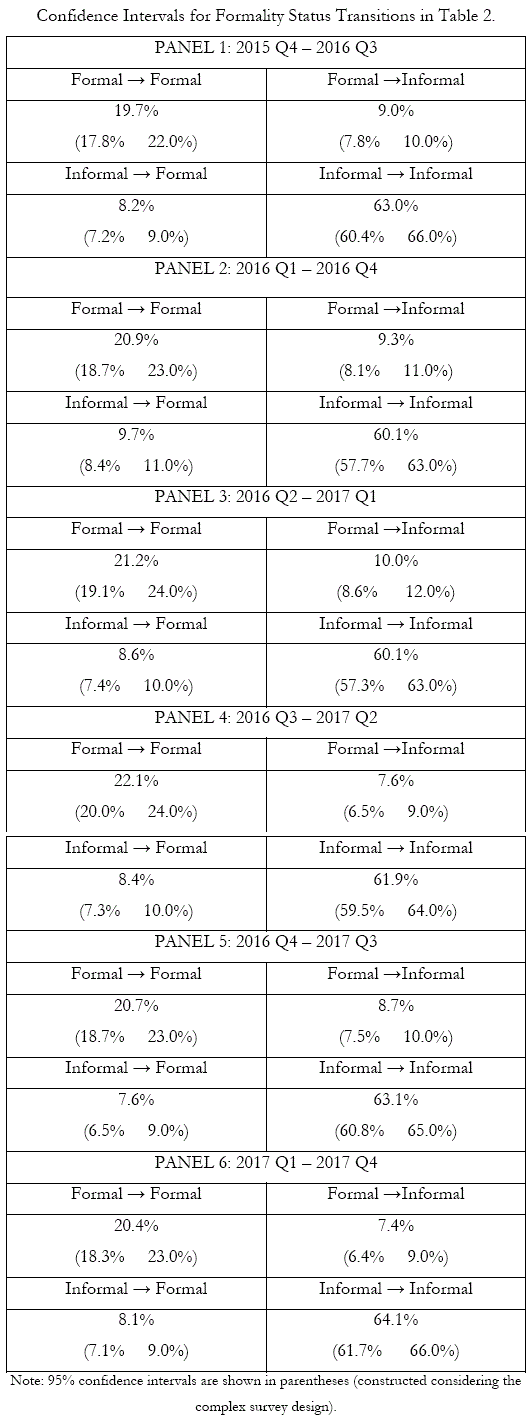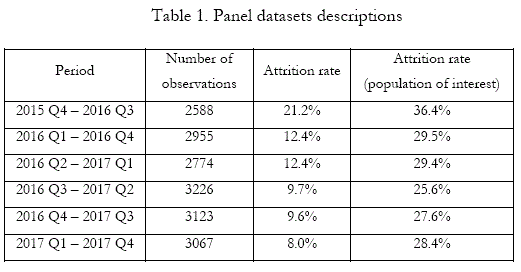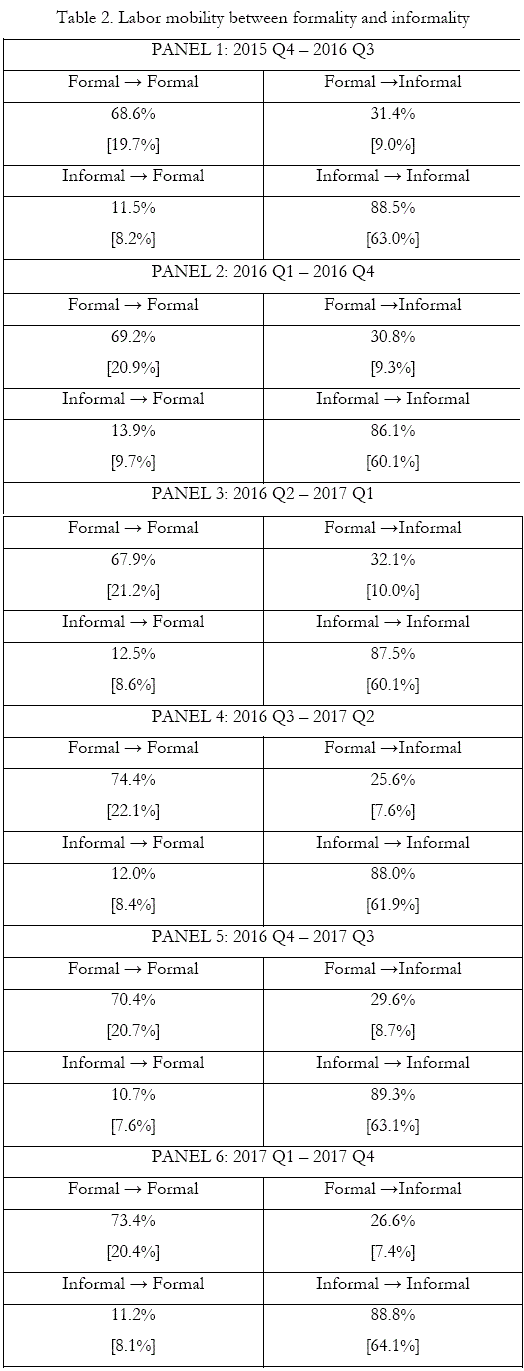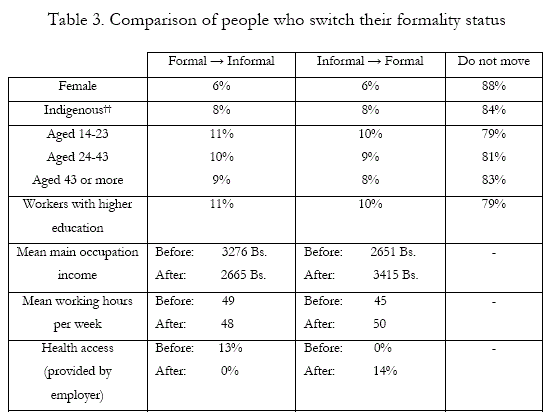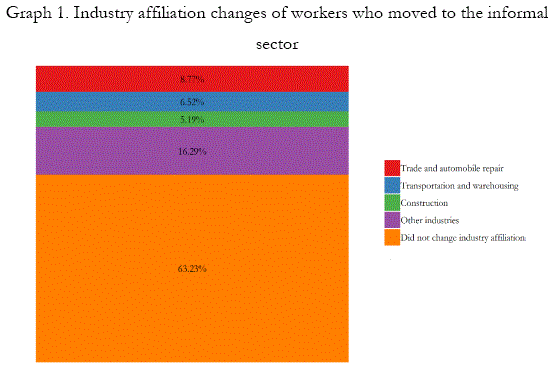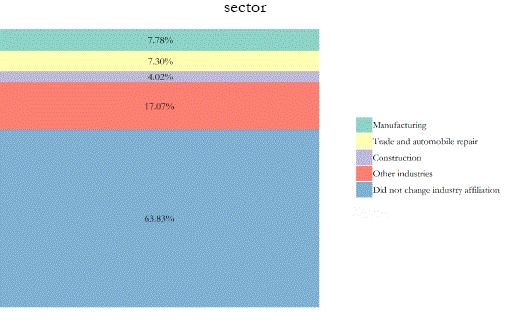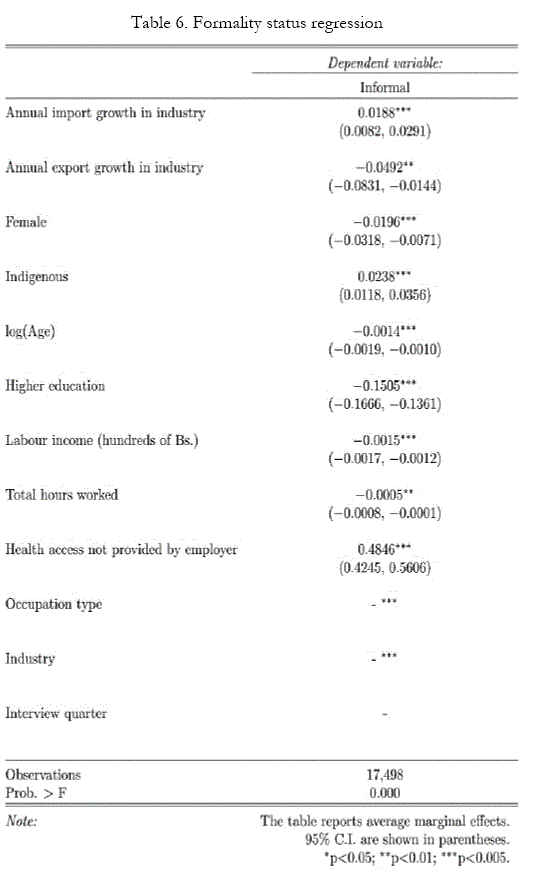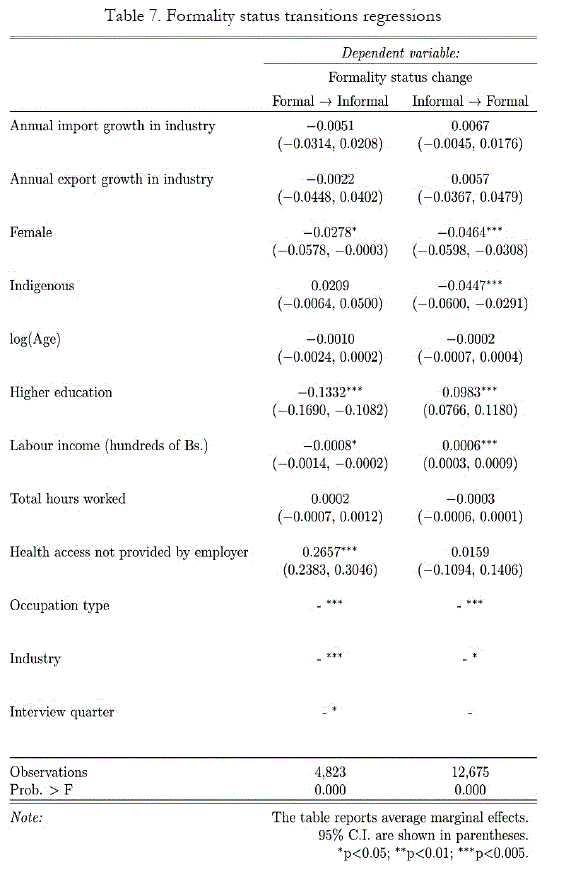Servicios Personalizados
Revista
Articulo
Indicadores
-
 Citado por SciELO
Citado por SciELO -
 Accesos
Accesos
Links relacionados
-
 Similares en
SciELO
Similares en
SciELO
Compartir
Economía Coyuntural
versión impresa ISSN 2415-0622versión On-line ISSN 2415-0630
Revista de coyuntura y perspectiva vol.4 no.3 Santa Cruz de la Sierra set. 2019
ARTÍCULOS ACADÉMICOS
La dinámica de la informalidad laboral y el comercio internacional en Bolivia
The dynamics of labor informality and international trade in Bolivia£
José Miguel Molina Fernández p
p Research consultant at CIESS Econométrica.
Correspondence address: Av. Arce Y Belisario Salinas N° 2355 Edificio:
Cobija Piso: 2 Oficina 201. La Paz, Bolivia. Email: joselito mmvi@hotmail.com
Recepción: 18/04/2019 Aceptación: 26/07/2019
Resumen:
Este documento tiene dos propósitos. El primero es presentar algunos datos básicos sobre la movilidad entre estados de formalidad e informalidad de los trabajadores en Bolivia entre 2016 y 2017. Posteriormente, se busca pistas sobre los factores que determinan quién se mueve -mediante estimación de regresiones- haciendo énfasis en el rol del comercio internacional. El acceso a la salud proporcionado por el empleador y el nivel de educación del trabajador parecen ser los determinantes más fuertes de las transiciones entre estados de formalidad e informalidad. La exposición al comercio internacional está asociada con la informalidad laboral, pero los resultados sugieren que no determina directamente las decisiones para pasar de la formalidad a la informalidad o viceversa.
Palabras clave. Informalidad laboral, movilidad, Bolivia, comercio internacional.
Abstract:
The purpose of this document is twofold. First, it seeks to explore some basic facts about workers' formality status mobility in Bolivia in 2016 and 2017. Then, regressions are estimated to find hints about the factors that determine who moves, with a special focus on the role of international trade. Employer-provided health access and the level of education of the worker seem to be the strongest determinants of formality status transitions. International trade exposure is associated with labor informality, but the results suggest that it does not directly determine decisions to move from formality to informality or vice versa.
Keywords. Labor informality, mobility, Bolivia, international trade.
CLASIFICATION JEL: J46, J62, F1 6.
I. Introduction
According to International Labour Organization data, the labor Ínformality1" rate in non-agricultural employment is even higher than 90% in some developing countries. The magnitude of the phenomenon has attracted the attention of academic researchers for many years. The empirical literature on the topic faces some important constraints, such as the diversity of ways in which informality can be defined and the difficulty of obtaining completely reliable information.
The frequently structural nature of informality can make it seem like something fixed, but informality is actually pretty dynamic at the individual worker level. Policies intended to reduce it (assuming that this can be taken as a policy goal) must be designed with a proper understanding of how large the proportion of workers that are constantly formal or constantly informal is, and what motivates people to switch status. With this knowledge, policy makers can design an effective incentive-based strategy to achieve their desired outcomes regarding the issue.
Trade exposure has sometimes been associated with informality in the literature and considering that merchandise trade as a percentage of GDP from 2004 to 2017 has consistently reached levels higher than those recorded for any year since 1960 in Bolivia, investigating this relationship can bring interesting insights.
In her literature review, Munro (2011) found contradicting evidence on the effects of international trade on informality, mainly because the response seems to depend on each country's characteristics. Two examples may help in illustrating why this is the case. In Vietnam, McCaig and Pavcnik (2018) found that lower export costs -induced by the U.S.-Vietnam bilateral trade agreement- created incentives for enterprises to move to the formal sector. On the other hand, in Brasil, Dix-Carneiro and Kovak (2017) showed that in regions exposed to import competition after the trade liberalization of the 1990's, workers moved to the informal sector where relative wages did not decrease (in contrast to what happened on the formal sector). What these cases tells us is that we need to look at import and export exposure separately, and that the response of informality to changes in trade trends will change depending on how countries deal with their new opportunities and threats.
The findings on the consequences of international trade on general labor mobility are also worth mentioning, since they contradict the notion that workers will automatically move to sectors or regions for which openness creates opportunities. For example, people affected by import exposure in India, Brazil, and Mexico did not move even 5 to 8 years after trade policy reforms in their countries, despite suffering declines in their relative income compared to the inhabitants of other regions (Topalova 2010, Kovak 2013, Dix-Carneiro and Kovak 2017).
Coupled with the results of Autor, Dorn and Hanson (2016), these findings suggest that (generally) international trade affects workers in developing countries through labor income changes, while in contrast, it affects workers in developed countries through employment status changes. In both cases, the direction of said changes depends on the region or industry associated to each worker.
The purpose of this document is twofold. First, it seeks to explore some basic facts about formality status mobility in Bolivia in 2016 and 2017. Then, regressions are estimated to find hints about the factors that determine who moves, with a special focus on the role of trade exposure. Section II describes the data used throughout the analysis. Section III computes formality status mobility estimates and descriptively characterizes those who move. Section IV discusses which variables affect the probability of moving from the formal to the informal sector and vice versa. Section V presents the conclusions and policy recommendations.
II. DATA
The Encuesta Continua de Empleo is a rotating panel employment survey that the Bolivia's government statistics agency has been carrying out quarterly since the last quarter of 2015. In what follows, I will be using data from every survey round until the last quarter of 2017 -latest available.
Since we are interested in labor informality, let's center our attention on people employed on the private sector, aged 14 years old or more, with labor income above the first percentile of the corresponding distribution (170 bolivianos, which is still less than 10% of the legal minimum wage).
According to the survey documentation, households included in the panel portion of the sample live in urban areas and are balanced in terms of socio-economic standings. Each of them is interviewed for four quarters and then leaves the sample. Consequently, we end up with six panel datasets, which Table 1 describes.
The attrition rate is the percentage of people who did not get to participate in the fourth interview for whatever reason. Ideally, we would like to be able to observe everybody that participated in the first interview in the last one, since not participating might be correlated with the variables that we will later analyze. Therefore, the results that follow must be taken with caution. The proportion of women, indigenous people and workers in each occupation and industry do not differ by more than around 3% between the initial and final samples. However, median income for the final sample is 11% higher. The attrition rates for our population of interest are higher maybe because it is harder to find employed people at home in the surveys.
Following international conventions (International Labour Organization, 2013), someone is considered to be employed in the informal sector when:
- Working as an employee for a firm without a taxpayer identification
- number and with five or less workers‡.
- Working in an own-account enterprise without a taxpayer
- identification number.
- Working as an employer without a taxpayer identification number and
- with five or less workers.
- Working for a cooperative enterprise, as an apprentice without
- remuneration, or as a domestic worker.
With this definition, the informality rate for the last quarter of 2017 is estimated at 72.8%, with a 95% confidence interval ranging from 71.8% to 74%§. Missing information in any of the criteria will cause the informality status to be undetermined. These observations, which account for less than 0.1% of the sample in each panel, are dropped from the dataset.
Trade variables are extracted from the international trade database of the Instituto Nacional de Estadística (Bolivia's government statistics agency). They are matched to each worker using the 2-digit International Standard Industry Classification (ISIC) on which the Bolivian industry classification the one used on the employment survey- is based on. Using the 2-digit classification balances the objectives of having a disaggregated classification and a sufficient number of workers in each industry. An industry is said to produce tradable goods and services if it registered any exports or imports during the study period. All other industries are considered non-tradable and have no direct trade exposure.
III. FORMALITY STATUS MOBILITY
What is the proportion of workers that remain either in the formal or the informal sector (for a 9-month period)? What is the proportion of workers that move between sectors? The data from the Encuesta Continua de Empleo 2015 Q4 2017 Q4 allows us to answer those questions. Table 2 shows i) the percentage of people in each status that moves and ii) the percentage of people from all of the sample in each of the possible four combinations of formality statuses for both periods (in brackets).
In a 9-month period, 17% of the workers switch their formality status, so most of the workers remain in their original sectors. However, the estimated mobility is higher than the 13% found in the 2010 Q1 - 2011 Q2 period studied by Canavire-Bacarreza et al. (2017)**. Moreover, the percentage of people that move within each sector is noteworthy. In only nine months, the percentage of formal workers who move to the informal sector is around 30%.
The number of people moving from the formal to the informal sector is statistically indistinguishable to that of the workers moving in the opposite direction in all of the six panels (see Appendix 1). We should expect this to keep informality rates pretty much constant over time.
There seems to be little variation between mobility estimates over our six panels. Therefore, it seems reasonable to estimate a long run informality rate using our transition estimates with Markov Chains. More specifically, we are interested in finding a formality status distribution that satisfies:
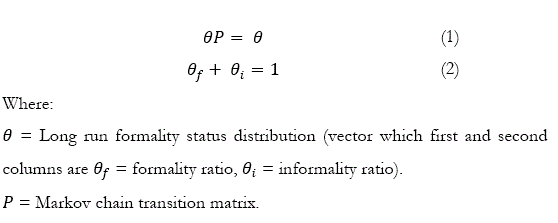
Taking the mean of the mobility estimates in our six panels, we have:

According to the estimations, the formality status distribution converges to an informality rate of 71.1%, which is not far from our 72.8% informality rate for the fourth quarter of 2017. This is consistent with the fact that approximately the same number of workers from each formality status switch to the other in a given period.
Who moves from one sector to another? Are people who switch from formality to informality any different from those who move in the opposite direction? Table 3 compares both groups:
No causal claims can be made, but our brief descriptive analysis shows some interesting facts. Both groups are similar in terms of gender, ethnic, age and education distributions but some differences appear when we look at time-variant variables (that is, things that a worker can change). People who move to the formal sector experience an increase in their main occupation income and health coverage, while the opposite holds true for those who move in the opposite direction. Then, it could be argued that, in most of the cases, workers are better off in the formal sector, but there may be other advantages to working in the informal sector, like more flexibility, less pressure (people who move to the formal sector work more hours), independence, etc.
We will later explore how industry trade exposure relates to the decision of switching one's formality status, so knowing to which industries switchers move might give us some relevant base information. Graph 1 examines the industry affiliation of workers who moved to the informal sector.
Most of the workers that become informal do not change their industry affiliation. However, those who do, move mostly to trade and automobile repair, transportation and warehousing, and construction. That is, they move to largely non-tradable industries.
As shown in Graph 2, workers that become formal are also not likely to change their industry affiliation, but manufacturing is the preferred sector for those who do (an industry that produces tradable goods). Interestingly, trade and automobile repair, and transportation and warehousing, are once again common destinations for switchers.
IV. THE PROBABILITY OF BEING INFORMAL VERSUS THE PROBABILITY OF MOVING TO A DIFFERENT FORMALITY STATUS
The fact that trade seems to have a degree of connection with our patterns of mobility poses an important question: are the informality rates for tradable and non-tradable industries any different? Table 4 reveals that the informality rate in non-tradable industries is 71%. However, this proportion is only slightly in tradable industries. This is probably caused by the fact that the panel datasets only include people from urban areas, excluding many workers in agriculture, which should be included on informality statistics according to the International Labour Organization (2013).
Table 5 shows the informality rates in tradable and non-tradable industries using the complete dataset from the last quarter of 2017 (including people living in rural areas). The results tell a very different story, since now the informality rate in tradable industries is higher than that in non-tradable industries. That is due to the fact that informality is much common in agriculture, a tradable sector whose workers usually live in rural areas. The changes from Table 4 to 5 are also driven by people working in the manufacturing of agricultural products, a sector that makes for most of the non-traditional exportable production in rural areas.
Given that we are interested in formality status transitions, we turn our attention back to the observations in the panel datasets, comprised of urban workers only (since transitions are invisible in cross-sections). Tables 4 and 5 are a cautionary notice to warn the reader about differences in the relationship between informality and international trade between urban and rural areas. All of the results that follow should be interpreted in an urban context and are possibly not applicable to rural dynamics.
We can explicitly explore the link between formality status transitions and international trade through regression analysis. A clear identification of a causal effect would require an experimental or quasi-experimental setting, something rare in studies about informality in Bolivia (CAF, 2017 is a notable exception). Since no particular historical event can be exploited for this purpose, the regressions will only give preliminary evidence on possible causal relations.
Trade exposure is defined separately for imports and exports. Ideally, we would like to measure import exposure with the import penetration ratio for each industry, as in Autor et al. (2014). The latter is a better measure of import competition since it represents the market share of foreign producers. Unfortunately, Bolivia's Input-Output tables have not been updated since 2012, so industry-level import penetration ratios cannot be calculated. The trade exposure measures for worker i in industry j at time t are defined as:

Where 'year exports' and 'year imports' for each industry j at quarter t represent the previous 12-month cumulative values of each variable. Put more simply, the export and import exposure measures are the annual growth rates of said variables. As import penetration information becomes available, updating the following results would be useful to check how the results change with this superior measure of competition.
As a first step, before diving into the analysis of transitions, it may be interesting to check which variables can predict if a worker in our dataset is informal (in his or her first interview). As our dependent variable is binary, we use a logistic regression. Note that the interest here is centered on the trade exposure variables and that the following regression cannot be understood as a structural equation with causal implications. For example, labor income is probably caused by informality (and not the other way round), but the variable is included to provide a point of comparison for the results from the mobility regressions which will be presented later. Most importantly, a regression of this form may be the first option that would come to mind for a researcher that only has cross-section data available. For occupation types, industry affiliation and interview quarter dummies, only the joint significance test result for the individual categories is included. The estimations consider the Encuesta Continua de Empleo's complex survey design. Table 6 shows the results.
While the average marginal effects of the trade variables are significant, their magnitude is not large. Even if imports or exports doubled in a worker's industry (a situation not likely to occur frequently), on average, the consequent change of the predicted probability of being informal would be of only 2% or -5% respectively.
Table 7 relates the same variables as measured in the first interview-to the probability of moving from one formality status to the other (over a 9-month period). One logistic regression is fit for each of the groups. The only relationship that appears to be non-linear (with respect to the logit transformation) is that with the age, so the logarithm of the variable is introduced in the equation. Notice that simultaneity issues are much less likely to appear in these regressions since the transition happens after the first interview. Again, the estimations consider the Encuesta Continua de Empleo's complex survey design. Following Abadie et al. (2017), standard errors are clustered at the primary sampling unit and industry levels.
For the most part, the results that turn out to be significant in each regression mirror those of the other. For example, while a formal worker that identifies as indigenous is expected to have a higher probability of moving to the informal sector, an informal indigenous worker is expected to have a lower probability of moving to the formal sector. An exception is gender, where females are less likely to move in either direction. This seems reasonable given that only 13% of all women change their formality status, while 20% of all men do according to the survey.
A notably important factor in determining changes in formality status seems to be the lack of employer-provided health access. On average, a formal worker without health coverage is 29% more likely to move to the informal sector. While health coverage is mandatory for permanent employees, firms do not always hire under that type of contract. A 57% of people in the formal sector without health access are employees, while a 43% are employers or own-account entrepreneurs.
Education also seems to play an important role. On average, for workers with higher education, the predicted probability of moving to the informal sector is 13% lower and the predicted probability of moving to the formal sector is 10% higher.
The results are consistent with the findings of lower mobility for women in Egypt (Tansel and Abidin, 2014), and the importance of education to increase the number of workers who remain in the formal sector and the number of workers who exit the informal sector in Egypt and Russia (Tansel and Abidin, 2014; Slonimczyk and Gimpelson, 2015). For both countries, age does not seem to influence transitions either. As these patterns appear in very different contexts, they need to be taken into account for future policies that seek to decrease informality.
According to Table 6, trade exposure is related to informality, but Table 7 suggests that it does not affect changes in formality status. How can this be? Graphs 1 and 2 give a possible explanation. As an important proportion of workers who move to the formal sector move to manufacturing (an industry exposed to trade), and an important proportion of workers who move to the informal sector move to non-tradable industries, the correlation between informality and trade exposure in Table 6 was expectable. However, that correlation does not imply that trade exposure in the previous firm was the reason to move.
Let me illustrate this with the example of a worker in a furniture factory. One day, this worker decides that he wants a more flexible working schedule to spend more time with his family, and as he lacks health access in his current employment anyway, he decides to quit his job (notice that the firm for which he worked did not change its formality status). In his last family dinner, a cousin told him that she was doing pretty well with her clothes selling business, so he comes up with the idea to start reselling shoes online. As he does not know how things will go, he does not register as a taxpayer. This is probably a common story. In this example, the correlation between informality and international trade exposure will originate from the fact that 'trade and automobile repair' happens to be a non-tradable industry‡‡, one where tax evasion is not complicated and one in which a high-level education is not always needed (the two latter characteristics of the industry are the ones that actually make it attractive). International trade exposure in the firm for which the worker in our example previously worked is not involved in any of his motivations to move (as in the results of Table 7).
While our results suggest that industry trade exposure does not affect workers' decisions of moving from one formality status to the other, it is still possible that informality and international trade might be related at an aggregate level (instead of at an industry level). Coming back to the example of our shoe seller, it was the profitability of importing shoes to sell them in the national market that led him to change its job, so his motivations were not related to anything happening in the furniture industry for which he previously worked.
The results support the idea that the response to import competition in a given Bolivian industry is not a decline in its employment levels, or a transition of its firms to informality, but rather a decline in the real wages of its workers, as evidenced in Molina and Gonzales (2018)§§.
V. CONCLUSIONS
This document explored formality status mobility, focusing on its relationship with international trade. The mobility of workers between the formal and the informal sector is not too high, and since the number of workers going in each direction is similar, the informality rate is not greatly affected by workers' transitions. The probability of moving is affected by a set of variables, among which the most relevant seems to be employer-provided health access. As in previous studies for Russia and Egypt, education also appears to decrease informality. While there is a correlation between informality and industry trade exposure, it is apparently not related to the workers' decisions of changing their formality status or not. Therefore, policies that try to reduce informality might need to look at other channels through which international trade can affect it (perhaps at an aggregate level) and to the possible reasons that cause workers to become or remain informal that were identified here.
The findings presented in this document also contribute to the body of evidence that shows that international trade does not generally affect developing countries through employment status changes, but rather through income changes (the latter statement being supported by the previously examined literature). This stylized fact can help policy-makers implement better strategies when trying to counteract the negative consequences of trade shocks.
The availability of genuine panel data allowed us to model workers' decisions explicitly***, and the results showed that the outcomes can be very different to those that come from modelling static correlations (in cross-sections). Since decisions are what matter for policymaking, efforts like the Encuesta Continua de Empleo are laudable and necessary.
Notes
£ This work was supported by funds from the Swiss Programme for Research on Global Issues for Development (r4d programme), implemented jointly by the Swiss Agency for Development and Cooperation (SDC) and the Swiss National Science Foundation (SNSF). The views expressed here are the author's and do not necessarily reflect those of the SDC or thoseofSNSF.
† From now on, let me refer to ‘labor informality’ simply as ‘informality’.
‡ In cases where the interviewee does not know if the firm has a taxpayer identification number, contributions to pension funds determine if the worker is formal or not.
§ Confidence intervals are computed considering the complex survey design.
** Which is more impressive taking into account that they studied a 15-month period. This is not necessarily a proof of increased mobility between periods, since people could move in and out of informality many times in between, even in seasonal patterns (this cannot be examined because of the length our panels).
†† A person is considered indigenous if said person identifies himself or herself as such.
‡‡ The notion that ‘trade and automobile repair’ is a non-tradable industry might be a little confusing, so it deserves some explanation. Trade -as a service- in a country like Bolivia is non-tradable because the seller does not compete with sellers from other countries (independently of the precedence of the good of service that is being sold). As e-commerce becomes more common, things could probably change.
§§ The data and code for replication of all of the results are available at https://dataverse.harvard.edu/dataset.xhtml?persistentId=doi%3A10.7910%2FDVN%2FQ0CXGA
*** The worker will not always make the choice. The firm in which he or she works could be the one deciding to move.
REFERENCES
Abadie, A., Athey, S., Imbens, G. W., & Wooldridge, J. (2017). When should you adjust standard errors for clustering? National Bureau ofEconomic Research. [ Links ]
Autor, D. H., Dorn, D., Hanson, G. H., & Song, J. (2014). Trade adjustment: Worker-level evidence. The Quarterly Journal of Economics, 129(4), 1799-1860. [ Links ]
Autor, D., Dorn, D., & Hanson, G. H. (2016). The china shock: Learning from labor-market adjustment to large changes in trade. Annual Review of Economics, 8, 205-240. [ Links ]
CAF (2017). Barreras a la formalización: evidencia para Bolivia. Available at http://scioteca.caf.com/bitstream/handle/123456789/459/Policy%20Brief_%20Barreras%20a%20la%20formalizaci%C3%B3n.pdf [ Links ]
Canavire-Bacarreza, G., Urrego, J. A., & Saavedra, F. (2017). Informality and Mobility in the Labor Market: A pseudo-panel's approach. Revista Latinoamericana de Desarrollo Económico, no 27, p. 39-56. [ Links ]
Dix-Carneiro, R., & Kovak, B. K. (2017). Trade liberalization and regional dynamics. American Economic Review, 107(10), 2908-46. [ Links ]
Hlavac, Marek (2018). stargazer: Well-Formatted Regression and Summary Statistics Tables. R package version 5.2.2. https://CRAN.R-project.org/package=stargazer [ Links ]
Kovak, B. (2013). "Regional Effects of Trade Reform: What Is the Correct Measure of Liberalization?" American Economic Review, 103(5), 1960 76. [ Links ]
Lumley, T. (2004). Analysis of complex survey samples. Journal of Statistical Software, 9(1), 1-19. [ Links ]
Molina, J.M. & Gonzales, R. (2018). Trade exposure and labor income in Bolivia. Manuscript sentforpublication. [ Links ]
International Labour Organization (2013). Measuring informality: A statistical manual on the informal sector and informal employment. [ Links ]
Munro, L. (2011). A literature review on trade and informal labour markets in developing countries. OECD Trade Policy Papers. [ Links ]
McCaig, B., & Pavcnik, N. (2018). Export markets and labor allocation in a low-income country. American Economic Review 108 (7): 1899-1941. [ Links ]
R Core Team (2018). R: A language and environment for statistical computing. R Foundation for Statistical Computing, Vienna, Austria. URL https://www.R-project.org/. [ Links ]
Slonimczyk, F., & Gimpelson, V. (2015). Informality and mobility: Evidence from Russian panel data. Economics ofTransition, 23(2), 299-341. [ Links ]
Tansel, A., & Ozdemir, Z. A. (2014). Determinant of Transitions Across Formal/Informal Sectors in Egypt. Economic Research Forum Working Papers (No. 899). [ Links ]
Topalova, P. (2010). "Factor Immobility and Regional Impacts of Trade Liberalization: Evidence on Poverty from India," American Economic Journal: Applied Economics. Vol. 2, No. 4, pp. 141. [ Links ]
Wickham, H. (2016). ggplot2: Elegant Graphics for Data Analysis. Springer-Verlag New York. [ Links ]
APPENDIX 1.
